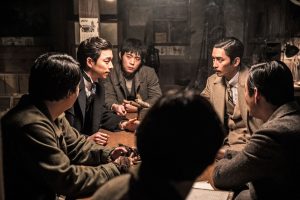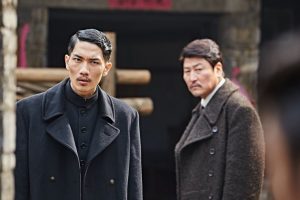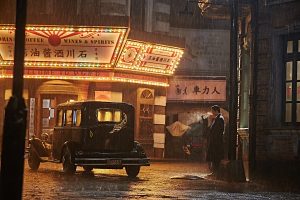 Title: The Age of Shadows | Rated: Not Rated | Runtime: 140 min | Theaters limited (reducing)
Title: The Age of Shadows | Rated: Not Rated | Runtime: 140 min | Theaters limited (reducing)
An auteur has returned home. It’s been three years since his Hollywood debut with The Last Stand and six years since his last Korean feature I Saw the Devil, and South Korean filmmaker Kim Jee-woon is once again making movies in his native land. His latest feature, The Age of Shadows, may mark a return to form; it has, after all, been chosen as the nation’s submission for next year’s Academy Award for Best Foreign Language Film. There’s no denying the breathtaking level of craft and entertainment in this espionage drama, even if its storytelling grasp does fall short of its reach.
 The story is designed to be a pressure cooker that keeps the audience on the edge of their seats, and for the most part, it fulfills just that. Taking place during the Japanese occupation of Korea during the 1920s, the film involves Korean resistance fighters attempting to smuggle explosives from Shanghai into their homeland, while the Japanese police – led by a conflicted Korean-born captain named Lee Jung-chool (Song Kang-ho) – seek to snuff out their plot. The nature of the film means that allegiances are always in question and that characters will act dishonestly from beginning to end, thus evoking a sense of confusion, distrust, and frustration that works quite wonderfully, particularly in later sequences. It’s even better when the buildup involves the characters feeling each other out to pinpoint their true loyalties and purposes, which typically comes in scenes involving Lee and resistance leader Kim Woo-jin (Gong Yoo) or Lee and hot-tempered Japanese officer Hashimoto (Um Tae-goo). That said, these elements of Hitchcockian suspense ring true, though the same cannot be said for the “whodunit” subplots that are peppered throughout since there are too many minor characters as suspected culprits. This storytelling decision would work had each suspect been memorable or unique, but that’s not the case as they tend to conveniently drop in and out of the story, making the whole thing seem needlessly convoluted. Also not helping matters is the difficulty in maintaining suspension of disbelief during certain sequences of events; several times, the characters kill and cause commotions in large crowds, which should be problematic since that would mean plenty of witnesses who could spell trouble for our protagonists, but the film somehow ignores this glaring issue in favor of chugging on.
The story is designed to be a pressure cooker that keeps the audience on the edge of their seats, and for the most part, it fulfills just that. Taking place during the Japanese occupation of Korea during the 1920s, the film involves Korean resistance fighters attempting to smuggle explosives from Shanghai into their homeland, while the Japanese police – led by a conflicted Korean-born captain named Lee Jung-chool (Song Kang-ho) – seek to snuff out their plot. The nature of the film means that allegiances are always in question and that characters will act dishonestly from beginning to end, thus evoking a sense of confusion, distrust, and frustration that works quite wonderfully, particularly in later sequences. It’s even better when the buildup involves the characters feeling each other out to pinpoint their true loyalties and purposes, which typically comes in scenes involving Lee and resistance leader Kim Woo-jin (Gong Yoo) or Lee and hot-tempered Japanese officer Hashimoto (Um Tae-goo). That said, these elements of Hitchcockian suspense ring true, though the same cannot be said for the “whodunit” subplots that are peppered throughout since there are too many minor characters as suspected culprits. This storytelling decision would work had each suspect been memorable or unique, but that’s not the case as they tend to conveniently drop in and out of the story, making the whole thing seem needlessly convoluted. Also not helping matters is the difficulty in maintaining suspension of disbelief during certain sequences of events; several times, the characters kill and cause commotions in large crowds, which should be problematic since that would mean plenty of witnesses who could spell trouble for our protagonists, but the film somehow ignores this glaring issue in favor of chugging on.
 The intricate plot gives plenty of room for the cast to make an impact, and most of them seize the opportunity. As Lee, Song – one of his nation’s most versatile working actors – handily balances exasperation and solemnity when putting up a front, and portrays the character’s struggle with divided loyalties with ease. Gong is a delight here, using his charisma to great effect as he mentally spars with Song in a battle of wits, and he certainly brings his dramatic chops when his character deals with the possibility of a mole within the Korean resistance. While Um is handed a rather one-note character, he gets incredible mileage out of Hashimoto’s vile disposition and dominates his scenes – look no further than how many times he slaps one of his hapless co-stars in one take. Lee Byung-hun clearly has some fun in his extended cameo as the head of the resistance, evidenced in one of the film’s more comedic scenes.
The intricate plot gives plenty of room for the cast to make an impact, and most of them seize the opportunity. As Lee, Song – one of his nation’s most versatile working actors – handily balances exasperation and solemnity when putting up a front, and portrays the character’s struggle with divided loyalties with ease. Gong is a delight here, using his charisma to great effect as he mentally spars with Song in a battle of wits, and he certainly brings his dramatic chops when his character deals with the possibility of a mole within the Korean resistance. While Um is handed a rather one-note character, he gets incredible mileage out of Hashimoto’s vile disposition and dominates his scenes – look no further than how many times he slaps one of his hapless co-stars in one take. Lee Byung-hun clearly has some fun in his extended cameo as the head of the resistance, evidenced in one of the film’s more comedic scenes.
 Known by many to be a stylistic director, Kim has crafted his most aurally and visually stunning film to date. The recreation of 1920s Korea and Shanghai is evocative and moody, especially during the night scenes when the presence of warm lighting lend a breathtaking chiaroscuro. Kim Ji-yong’s sweeping cinematography suit the director’s kinetic sensibilities, and the way he captures movement makes for some of the most arresting and memorable scenes seen this year on film. On sync with the images is the surprising yet clever use of Western music, such as Antonín Dvořák’s “Danse Slave Op 72 n°2,” Louis Armstrong’s “When You’re Smiling,” and Maurice Ravel’s “Boléro.” Also showcased is the director’s penchant for violence, which he effectively builds up to before resulting in startling bursts of blood and gore. All of these elements come together to form astonishing sequences, with a highlight being the film’s train-set centerpiece, which is indubitably better to be experienced than described.
Known by many to be a stylistic director, Kim has crafted his most aurally and visually stunning film to date. The recreation of 1920s Korea and Shanghai is evocative and moody, especially during the night scenes when the presence of warm lighting lend a breathtaking chiaroscuro. Kim Ji-yong’s sweeping cinematography suit the director’s kinetic sensibilities, and the way he captures movement makes for some of the most arresting and memorable scenes seen this year on film. On sync with the images is the surprising yet clever use of Western music, such as Antonín Dvořák’s “Danse Slave Op 72 n°2,” Louis Armstrong’s “When You’re Smiling,” and Maurice Ravel’s “Boléro.” Also showcased is the director’s penchant for violence, which he effectively builds up to before resulting in startling bursts of blood and gore. All of these elements come together to form astonishing sequences, with a highlight being the film’s train-set centerpiece, which is indubitably better to be experienced than described.
While The Age of Shadows doesn’t quite live up to the likes of Kim’s earlier works, it nevertheless is further proof of why he is South Korea’s greatest modern auteurs. The story definitely needs some refining, but on display here is audacity, vision, and mastery of filmmaking craft – sought by many but paralleled by few.
Rating: 3.5/5.0
* Photos courtesy of CJ Entertainment America
